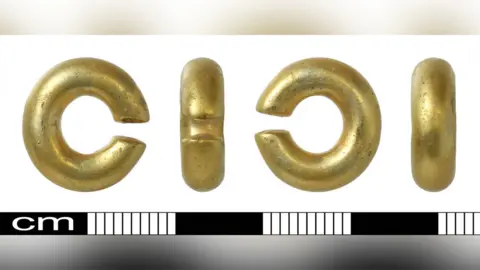Mysterious gold Bronze Age ring donated to Norwich museum
 Andrew Williams/Norfolk County Council
Andrew Williams/Norfolk County CouncilA curator has praised a metal detectorist and landowner for giving an "incredibly mysterious" Bronze Age gold penannular ring to a museum.
The 14.5mm (0.5in) ring has been declared treasure by a coroner.
Norwich Castle Museum curator Tim Pestell said: "It's Norfolk people helping to build up Norfolk county collections for future generations."
Dr Pestell said the museum tried to add all the county's Bronze Age gold finds to its collections.
 Andrew Williams/Norfolk County Council
Andrew Williams/Norfolk County CouncilThe penannular ring - which means it has a small part of its circumference missing - was found in north Norfolk.
The museum's curator of archaeology said: "We're very, very selective about what we acquire because we record about 1,600 finds a year and we take in a quarter of 1%, so what we really do try to do is bring in objects that enhance our collection."
Dr Pestell added that prehistoric gold was "not at all common" and this object had "an incredible potential to unlock future stories".
Adding it to the museum meant it could also be studied in the future, to "create a narrative about how people lived, worked and died in the past".
About 12 gold penannular rings have been found in the county since the Portable Antiquities Scheme was set up in 1997.
"There are something like 150 in the whole country, so not everyone would have had one," said Dr Pestell.

Metal detecting and the law
- No search can begin until permission has been given by the landowner
- All finds belong to the landowner
- Any find in England, Wales and Northern Ireland that is more than 300 years old, made of gold or silver, or found with gold or silver artefacts, could be treasure under the 1996 Treasure Act
- These must be reported to the appropriate county finds liaison officer
Source: Portable Antiquities Scheme

The tiny object raises questions about who made it and how much it might have been worth, at a time when people were living off the land and in "constant fear of drought or pestilence", he said.
No-one knows how they were worn or how long it would take before someone was able to afford to invest in items like the ring.
The county's finds liaison officer, Helen Geake, described it as "incredibly mysterious" and said its exact use was not clear.

Find BBC News: East of England on Facebook, Instagram and Twitter. If you have a story suggestion email [email protected]
